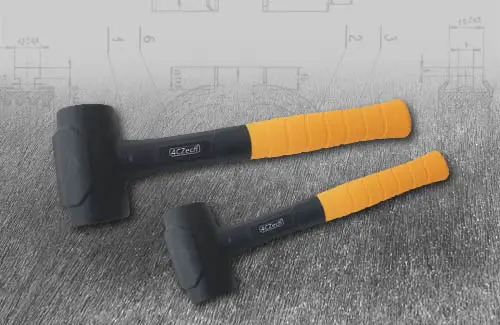The regular price is the current manufacturer's recommended price! FREE shipping for orders over EUR 41,67 within CZ+SK (PPLparcel)

Assembly mallets, also known as rubber mallets or non-rebound hammers, are special tools used in industry, crafts or assembly where a controlled blow without recoil is needed. Thanks to their design, they minimize the recoil after the blow, which allows for precise and safe work.
How do assembly mallets work?
• The head of the mallet is usually made of a soft material such as rubber, nylon or polyurethane.
• The non-rebound properties are achieved thanks to a core filled with loose material (e.g. sand or steel balls) that absorbs the impact energy.
• The result is a powerful, controlled blow without the risk of recoil, which protects both the user and the work surface.
Main advantages of assembly mallets
1. Work safety
Impact absorption reduces fatigue and the risk of wrist injuries.
Minimizing rebound increases the accuracy of the blows.
2. Surface protection
The soft head prevents damage to sensitive materials such as wood, plastic or soft metals.
Ideal for assembly work where it is important to maintain an intact appearance.
3. Versatility
Used in many industries: furniture assembly, pipe work, masonry and construction work, automotive industry or tile work.
Types of assembly mallets
1. Simple rubber mallets
Used for lighter work, such as laying tiles or assembling furniture.
Available in different rubber hardnesses.
2. Non-rebound hammers and mallets
Have a core with sand or steel balls inside.
Ideal for changing tires and working on gearboxes
Suitable for mold making, wooden furniture, gas industry, chemical industry, mining industry, mines, sheet metal work, aviation or shipbuilding.
3. Combination hammers
They have two different heads (e.g. rubber and plastic) for greater versatility.

Tips for choosing an assembly hammer
1. Size and weight:
• For delicate work, choose a lighter model (300-500 g).
• For heavier blows, go for heavier options (1 kg and more).
2. Head material:
• Softer materials: Suitable for working with wood and fragile surfaces.
• Harder materials: For robust assembly of metal parts.
3. Handle quality:
• Ergonomic handle ensures a comfortable grip.
• Anti-slip surface increases safety.
Other articles:
Jak vybrat správný ruční závitník?
Jak vybrat ráčnu
Sady nářadí
Posuvná měřítka alias šuplery